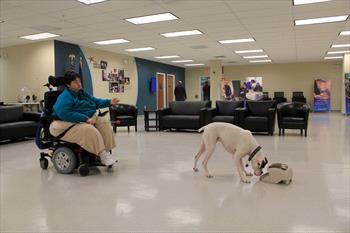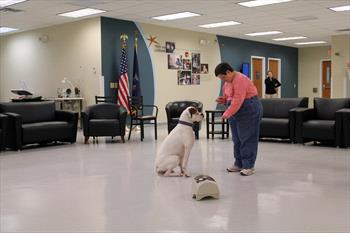While many trainers and pet owners use the Treat&Train® for training their pets, one unique use occurs at Ontario ARC (OARC), a facility whose mission is to “create great opportunities for people with intellectual and developmental disabilities.”
Their Pet Connections Program uses Animal Assisted Interventions to encourage individuals with various disabilities to improve their range of motion, work on strength and endurance, and to enhance their social interactions with others. The program headed by Program Manager, Gail Furst, CPDT-KA, in conjunction with the Occupational Therapist, Brenda Burton, uses the Treat&Train® for individuals who are unable to deliver the treat to the dog using their hands. This may be caused by mobility limitations or sensory integration.
For instance, this photo depicts an individual working with Albert a 5 year old Boxer trained as a therapy dog. The individual is in her wheel chair and is using the remote control to reward Albert for touching the target stick.”
States Burton, “This individual is working on improving her fine motor control and endurance by pressing the remote to the Treat&Train during several consecutive training tricks. In addition, she is working on improving her response speed by timing her pressing of the remote at the same time Albert touches the target stick. Both of these skills will assist this individual in being more independent as she will be able to more readily manipulate small items such as buttons on clothing as well as be safer within her environment, as she will be able to recognize and react to outside stimulus in a timelier manner. Working with the dogs is very motivating for our participants and this training session is also assisting this individual in obtaining skills that could be beneficial in helping her obtain a job in the community.”
This photo demonstrates an individual who does not want to touch the treat or feel Albert’s mouth. Burton states, “The sensation of Albert’s saliva and jowls can be overwhelming for this individual and result in her sensory system becoming overactive.”
The individual can still get the opportunity to train because she is able to press the remote control and hence dispense treats from the Treat&Train to reward Albert for sitting on cue. This individual is working on skills that could help her obtain a job within her community working with canines. As with the first individual, she too is working on improving her response speed and fine motor skills while maintaining a neutral sensory system.
Burton states, “This particular individual is also working on improving her visual perceptual skills to watch Albert closely and recognize his changes in body positioning. Acknowledging and understanding of Albert’s changes in position also addresses body scheme awareness which is beneficial for this individual as she experiences some challenges recognizing her own body scheme when maneuvering throughout her environment.”
If you’re as fascinated by this form of occupational therapy as I am, you’re itching to know more. Luckily both Gail Furst and Brenda Burton agreed to participate in a Q&A.
Question:
Explain what Ontario ARC does and what the Pet Connection program is.
Answer:
Gail and Brenda: The Pet Connections Program is designed to provide individuals with developmental disabilities the opportunity to interact and learn new skills related to animals. Participants also learn how to recognize animal behaviors, signs of stress, calming techniques, as well as job related tasks. Animals are motivational and inspirational, therefore assisting participants in meeting their therapeutic goals.
Question:
Gail and Brenda, What are your position at Ontario ARC and what do you do?
Answer:
Gail: As program manager, I oversee the program development in conjunction with our occupational therapist, Brenda Burton OTR/L. I am also responsible for educating staff on dogs’ body language and positive reinforcement training and am the lead dog trainer for our therapy dog classes.
Brenda: As the occupational therapist, I assess our individuals and review their medical records to determine what their specific needs are. I then discuss with Gail the occupational therapy (OT) related goals that I propose. Gail will then offer suggestions on what a dog can do to assist in meeting those goals. Gail provides the necessary training suggestions to our volunteer handlers so they can work with their dog to help them feel comfortable with the exercise required to meet a particular OT goal. We then begin working with the dogs and our individuals to determine an appropriate treatment plan for everyone.
For instance, we have one individual who is diagnosed with scoliosis, as a result of the curvature of her spine, she has a compromised right lung. Therefore, exercising and sometimes breathing is a challenge for her. However, she will readily and happily engage in walks with the therapy dogs while at her day program. Her breathing is closely monitored and the distance of her walks are all documented. In addition to these walks, this young woman will engage in petting the various dogs while they are in a down position on her left side. While she is happily petting the dogs, she also tolerates slight stretching and trunk elongation on the right side of her body while leaning over to reach the dogs with her left. Lastly, this particular individual also works on maintaining or improving her lung capacity by blowing bubbles to the dogs and/or using a straw to blow small pieces of kibble across a table to the dogs positioned on the other side. All of these activities help to improve or maintain her respiratory endurance while she is enjoying “playing” with the dogs.
Another example is that we have an individual who is diagnosed with cerebral palsy and therefore has limited use of his right arm. Although appropriate range of motion and strength are noted in his left arm, he has some difficulty with motor planning to complete purposeful movements. Therefore, we began working with him by having him reach in various planes to pet a dog. The key was working on his being gentle when petting. This particular individual caught on quickly that if he was too rough the dog would not stay for him to pet. As his ability to reach the dog and engage appropriately improved, we then began looking to expand his skills. Other staff had reported that he is able to independently grasp his drink cup, but he tends to put it down to hard and spill it. This gave us the idea to work on this skill with the dog, he had already mastered being gentle with the dog. We showed this gentleman a cup where I placed a small piece of kibble in the cup, he was asked to grasp the cup and gently bring it to the dog. After being able to reward the dog with the kibble with minimal assistance from the therapist, he has now begun to manipulate the cup independently to grasp from his left side and place in front of the dog on his right. Although this skill is sporadic, it shows an increase his motor planning and control and will therefore increase his independence and success with self-feeding.
Question:
How long has the program been in existence and why was it formed. (e.g you talked about speech therapy, music therapy, and physical therapy)?
Answer:
Gail and Brenda: The program has been running for 2 years and was developed as an alternative “treatment” to meet their individualized goals. Working with animals is motivational and inspiring, resulting in greater growth of our participants in a shorter period of time. Our programs are designed to teach our participants skills to improve their independence as well as their quality of life.
Other alternative therapies at Ontario ARC include our Creative Expressions Program. Creative Expressions is a trio of programs designed to inspire the artist within, Creative Expressions offers instruction in art, music and horticulture. Classes are offered in small groups and participants have access to a music laboratory, art studio, and outdoor greenhouse. From flower arranging to vocal lessons to watercolor portraits, there are a variety of different mediums for individuals to explore and express themselves. Currently Pet Connections is collaborating with our Music Therapy program, as we have had an individual train Albert to press an “ablelink” as part of the Bell Choir’s rendition of “How Much is That Doggy in the Window?” We have also had dog teams dancing during the Bell Choir’s rendition of “It’s Now or Never.”
Question:
Why did Ontario ARC start this program when they already have other programs?
Answer:
Gail and Brenda: Ontario ARC developed this program as it is unique and offers participants the opportunity to work with animals in a purposeful way. Participants do not realize how hard they are working as they are enjoying the time spent with the dogs. There are no other programs like this on the east coast and makes Ontario ARC one of a kind.
Question:
Why should other similar organizations start a therapy dog program?
Answer:
Gail and Brenda: Because we know that dogs have the remarkable ability to raise people’s spirits and improve their well being!
For instance, we have a young woman who is diagnosed with Down Syndrome as well as arthritis. Although she uses a wheelchair, her physical therapist was working on improving her leg endurance and strength to maintain/improve her ability to maneuver her own wheelchair independently. However, this particular individual was refusing to use a stander to work on lower extremity weight bearing and strengthening on her days away from PT and her therapist was looking to discharge her. One day, I happened to be in the building with a therapy dog when her staff approached me and asked if I could try to get her into the stander. Well, as soon as she saw the dog she was up for trying anything as long as she got to play with him! We now work together on a weekly basis and she has increased her tolerance for the standing from 4 minutes in it to 15 minutes in it. While in the stander, we address her shoulder range of motion and strength by dispensing treats through tubes to the dog, having the dog complete a paws up on her stander tray and ask her to don him with Hawaiian lays or Mardi Gras beads, as well as engaging in petting and brushing the dog. She has addressed her fine motor skills by using large tweezers or chop sticks to pick up kibble and then dispense into a dish for the dog to enjoy. All of this “work” is fun and has been beneficial in improving her lower extremity use while justifying the Physical Therapist keeping her on his caseload and developing new and more challenging goals during therapy sessions.
As you can see this unique program provides tremendous benefits for the patients and also for the staff. It must be wonderful having patients who look forward to their therapy when it involves a dog. And rewarding to see them progress steadily. So the program makes the tasks easier for both the patients and the therapists! Hopefully more institutions will be using Animal Assistance dogs as part of their Occupational Therapy programs.




